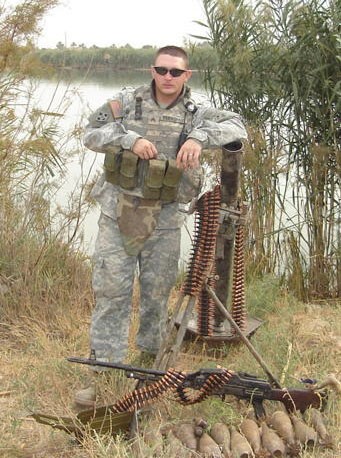LOUISVILLE, Ky. - After 12 improvised explosive device (IED) attacks, a traumatic brain injury, nine staples in his head, a diagnosis of severe post-traumatic stress disorder after two tours in Iraq, Nicholas Ebbinghaus is thankful for the opportunity to work with the U.S. Army Corps of Engineers' Louisville District.
The Army's Wounded Warrior Program and the Corps' Civilian Personnel Advisory Center (CPAC) coordinated to bring 30-year-old Ebbinghaus on board as an administrative assistant in the contracting division in February 2010.
"If it wasn't for the Wounded Warrior Program, I'd still be looking for a job," Ebbinghaus said.
The Wounded Warrior Program is designed to transition wounded Soldiers into civilian jobs where they can utilize their skills.
"A lot of people see that [Soldiers] were wounded in Iraq and think that they may not be able to do their jobs up to their standards, but [the Army] is helping former Soldiers find jobs in the civilian world," Ebbinghaus said.
Joseph Tober, human resources specialist, who coordinated Ebbinghaus' transition, felt that he was a good candidate for the job from their first conversation. "I got the feeling that Nic wanted to work," Tober said. "It didn't really matter what the position was, he just wanted to work."
A painful history in Iraq
The Ohio native's Army career began in 2002, when he decided he wanted to get out of the local area and explore the traveling opportunities the Army offered.
That decision led to his first deployment in 2003, where he served with the 3rd Battalion, 18th Field Artillery Regiment, 17th Brigade out of Fort Sill, Okla. He was stationed at Forward Operating Base Bulldog in Balad, Iraq.
"If there was a mortar attack we went out and looked for the mortar men," he said. During this tour he encountered many difficult scenarios, but losing two of his good friends made the job extremely difficult. The two Soldiers, one who was filling in for Ebbinghaus, were killed by al-Qaida disguised as civilians while preparing for a controlled blast for weapon caches.
"It made it hard to get close to people with friendships and relationships," Ebbinghaus said. "I always kind of second-guess everything." Knowing that he should have been there that day still bothers Ebbinghaus. "It just eats at me and it's probably something that will never go away."
The tragic event made returning to Iraq for his second deployment in 2005 difficult. This time he served with the 29th Field Artillery Regiment, 3rd Brigade Combat Team, 4th Infantry Division. He was stationed at FOB Anaconda in Balad, near the Sunni Triangle, known as the "Triangle of Death." Now a staff sergeant, part of his job as a patrol commander was to perform weapon cache searches and look for IEDs.
One day, Ebbinghaus' vehicle and two other trucks were attacked twice by IEDs.
"It was so fast-paced; while it was happening I tried to get everyone out of the area, make sure nobody was injured and make sure the vehicle was okay," Ebbinghaus said. "There's really no time to think, it's all just reaction. Then, afterwards you just wonder...why'"
In total, Ebbinghaus endured 12 IED attacks during his stint overseas which led to multiple concussions and ultimately a traumatic brain injury. "It makes everything inside you feel like it's moved," he said. "There's a lot of stuff I don't remember - I don't know if it's from the head injury, or from blocking it out."
After returning home in December 2006, he became a recruiter for Cleveland Recruiting Battalion until 2009. "I had a rough transition into that," he said, "Knowing what I went through over there and then putting kids into the Army to go and do the same thing. It was just a constant reminder of what happened," Ebbinghaus said.
Transition to civilian life
In 2009, Ebbinghaus was medically retired from the Army and looked to the Wounded Warrior Program to help him find a position where he could put his talents to use.
He admits the transition from the active-duty Army to civilian life at the Corps has been difficult. "You get so accustomed to Army life, then you get pushed out of that," Ebbinghaus said. "It's hard to explain," he said, "you go from working with all guys in a combat unit to coming here where it's slower paced."
His supervisor, Contracting Division Chief Mark Yates, said he believes Ebbinghaus has handled the change pretty well. "In his short time here, he's adjusting to the civilian workforce atmosphere well," Yates said.
Ebbinghaus is the third wounded warrior the Louisville District has hired in the past year.
"I believe the Wounded Warrior Program provides a win-win situation for the district," Yates said. "Nic will definitely be an asset to our organization. He is extremely efficient and hard-working, with a great attitude."
Tober feels the same way about Ebbinghaus' abilities, "You can tell he's going to get the job done," he said. "He's only got one way to go, and that's up."
Outside of work, Ebbinghaus enjoys driving to Cleveland to visit his parents on the weekends, playing video games and playing bass guitar. He has used music as a way to heal from the painful memories. "Music helps," Ebbinghaus said. "It takes your mind off everything."




Social Sharing